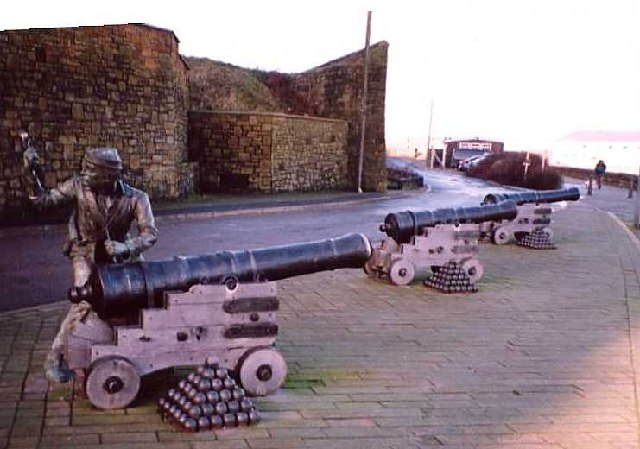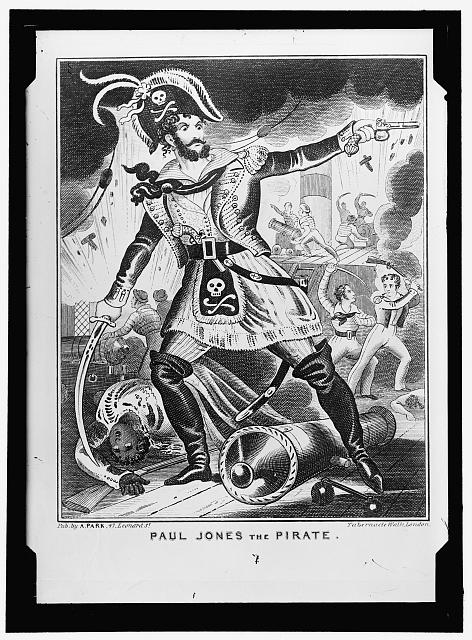When discussing the American Revolutionary War, it is easy to assume that all of the fighting took place on North American soil. While this true to some extent, there were some notable and strange battles that took place not only outside of America, but even on British soil. The raid on Whitehaven, led by John Paul Jones, is the only such attack to reach the British mainland.
A Continental Navy captain of the name John Paul Jones had made quite the name for himself, and in 1778, he wanted to stage a daring assault on British soil. Previously, he had been operating out of France, sailing up and down the Channel trying where he could to disrupt the British and help the war being fought across the Atlantic Ocean.
Venturing into the Irish Sea in the hopes of inflicting damage against merchant shipping, he concocted his plan to attack the British at their own doorstep. This was something that would have been considered impossible, thanks to the vast distances between the United Kingdom and the United States, and the incredible might of the Royal Navy.

At the time, the British Royal Navy was unrivaled in power and was capable of decimating any naval force brave enough to face them head-on. For this reason, John Paul Jones’s crew and other American ships adopted the tactic of harassment, striking supply lines and merchant shipping where possible. Jones was aware of the Royal Navy’s strength, so he wanted to strike with the element of surprise.
Jones was to strike at the port of Whitehaven on the coast of Cumbria. The plan of attack was to anchor his ship, the Ranger, out at sea and head into the port at night with 30 volunteers in two dinghies. One crew was to attack and silence a British fort guarding the harbor, while the other was to sabotage the town and set the 200 ships in the harbor alight.
Finally, the British would feel the heat of this war on their own turf.
Why Whitehaven? Was Whitehaven strategically important? No. Jones chose it because he was born and raised in the U.K. and began his sailing career from the port of Whitehaven. Because of this, he had intimate knowledge of its layout to help him find his way around at night.
His career started at the young age of 13, eventually becoming the captain of a merchant vessel at just 21 after the captain of the ship he was on suddenly died from yellow fever, leaving Jones to navigate the ship back. After commanding this ship for a while, his reputation took a dive for the worse when he flogged a member of his crew so severely that he died a few weeks later, causing him to be seen as overly cruel.
Jones left Scotland after this, captaining another vessel in Tobago for over a year before killing yet another member of his crew after a dispute. Fleeing from the potential legal repercussions, he relocated to Virginia in the U.S., a nation that from then on he would regard as his own.
Off the coast of Whitehaven, the Ranger‘s anchor was dropped, and the two crews set off for the port just after midnight on April 23, 1778. Immediately, they were faced with a strong wind and tides, slowing their journeys significantly.
Upon arrival, Jones’s crew made their way into the fort, successfully and quickly silencing its dangerous cannons. Jones had difficulty starting any fires, as the fuel for their torches had run out on the unexpectedly long journey to shore.

Exiting the fort, Jones was greeted with a very noticeable lack of burning vessels in the harbor. Meanwhile, the other crew had also run out of fuel, forcing them to find their own in Whitehaven. On this hunt, they had conveniently entered a public house, and got caught up in more important matters, namely, having a drink!
By the time Jones linked up and rallied his men, they were drunk, and the sun was coming up, forcing them to abandon the goal of burning the entire port to the ground in exchange for claiming a single coal ship that they hoped would spread fire to other moored boats when ignited.
With success seeming impossible, the situation was made worse by a traitor in Jones’s own crew, running around the town to warn the townspeople of the attack. This traitor had only joined the Continental Navy for a free ticket back to the U.K.
Back in the port, Jones and his crew managed to successfully set the large coal ship alight, but thanks to the alerted townsfolk, the fire was quickly suppressed. Jones and his men jumped back into their dinghies and headed back to the Ranger in the morning light, well aware of their failure.
For a man like Jones, this failure was unbearable, so he set sail for Scotland hoping to kidnap the wealthy Earl of Selkirk to use him as a bargaining tool to retrieve captured Americans from the British.

Gathering yet another crew, he rushed ashore, entering the stately home of the Earl. With another stroke of bad luck, Jones discovered the Earl was all the way down in London. Exhausted, deflated, and suffering yet another defeat, the crew opted to steal the Earl’s silverware.
Despite the total and utter failure of both of Jones’s plans, which nearly resulted in a mutiny, the attack did ruffle some feathers in Britain, which had previously insisted the mainland was safe from American attack.
Jones would take the Ranger to Ireland the next day to attack the Drake, a British warship. After engaging in combat, Jones successfully captured the ship, returning both it and the Ranger back to France.
This attack was the only one on British soil, and unlike the situation in North America, it didn’t end in the American’s favor. Jones would later go on to be remembered very differently in the two countries, as a hero in the U.S., but as a working-class pirate in the U.K.
John Paul Jones was Symbolically Pardoned by the town of Whitehaven in 1999.
/arc-anglerfish-arc2-prod-mco.s3.amazonaws.com/public/AEA7VSGAKBHL3AU4VMGGVT2KXQ.jpeg)
Not as perfect as many would believe... Thanks!
ReplyDelete